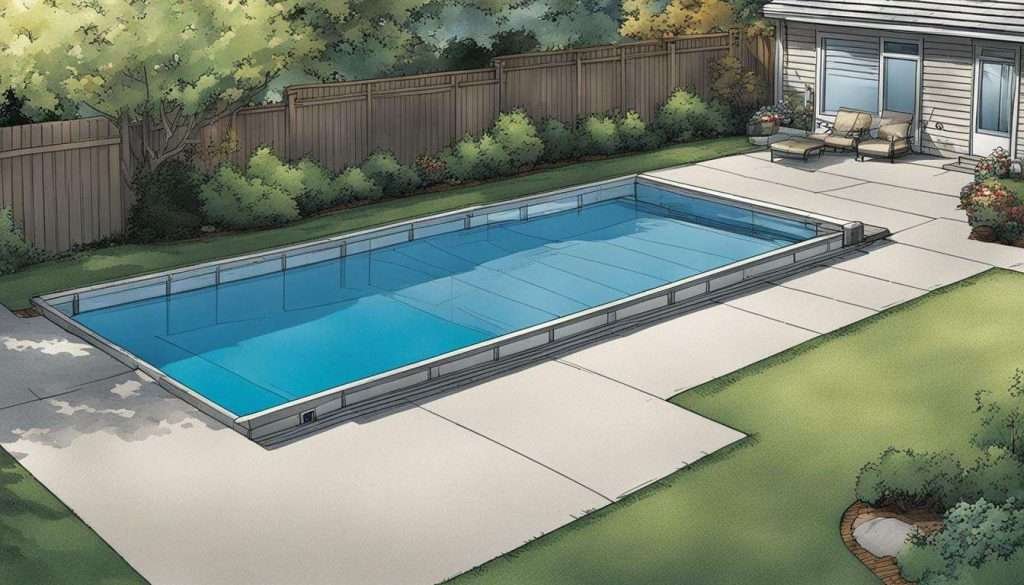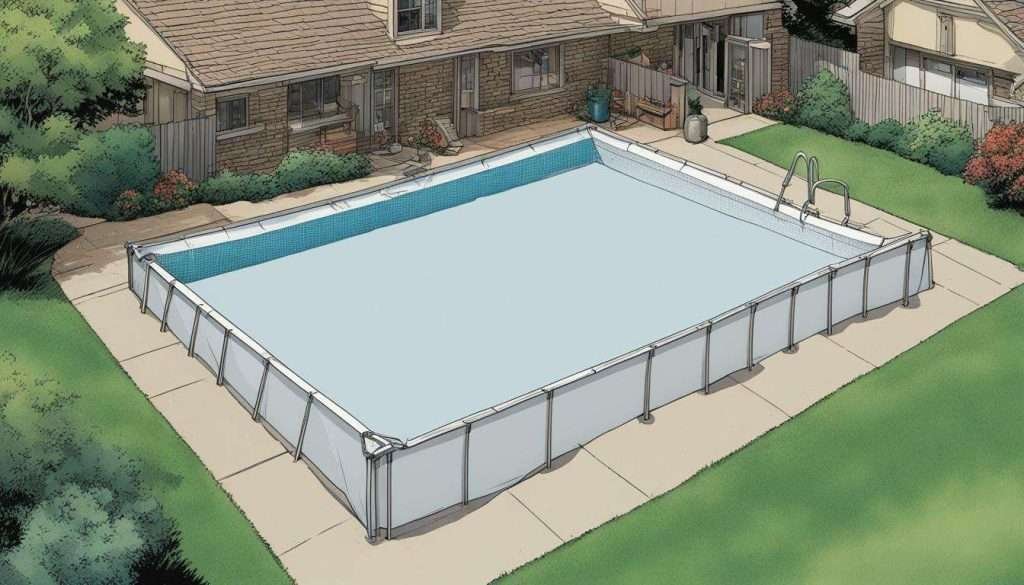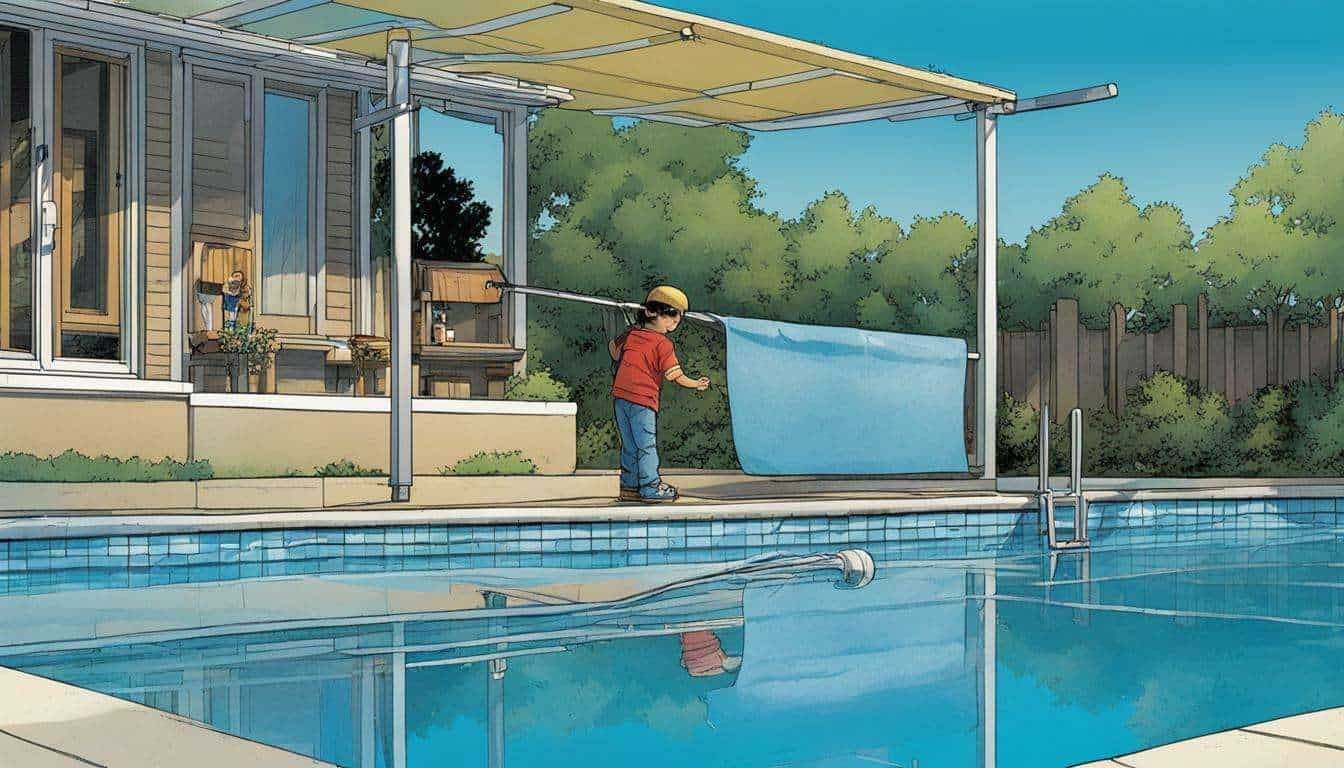Pool cover safety tips are crucial for maintaining a safe pool environment and protecting your loved ones. A pool cover is necessary to prevent slips and falls, debris, and evaporation in an uncovered pool. There are various types of pool covers available, including thermal blankets, child and pet safety covers, and automated vinyl covers. It is important to choose a durable cover that is made of high-quality materials and to regularly inspect and repair it. Pool covers have several benefits, such as reducing evaporation, decreasing chemical usage, keeping out leaves and dirt, retaining heat, saving money, and ensuring safety. It is important to use caution when walking on certain types of pool covers and to be aware of the potential risks. When compared to pool fences, pool covers offer more benefits in terms of safety. The lifespan of a pool cover depends on factors such as climate and usage. Proper installation and electrical consideration should be taken into account when using motorized pool covers. Additionally, children and pets should be kept away from the pool while the cover is on, and regular inspections and maintenance are necessary to ensure safety. Pool covers should be cleaned and stored properly, and energy-saving practices can be implemented to maximize their effectiveness.
Key Takeaways:
- Pool covers are essential for maintaining a safe pool environment and protecting your loved ones.
- There are different types of pool covers available, including thermal blankets, child and pet safety covers, and automated vinyl covers.
- Regularly inspect and repair your pool cover to ensure its durability and effectiveness.
- Pool covers offer several benefits, including reducing evaporation, decreasing chemical usage, and retaining heat.
- Use caution when walking on certain types of pool covers and keep children and pets away from the pool while the cover is on.
Why Pool Covers are Essential for Safety
Pool covers play a vital role in ensuring pool safety by preventing slips and falls, keeping out debris, and minimizing evaporation. By investing in a high-quality pool cover, you can create a secure swimming environment for your family and enjoy peace of mind.
One of the key benefits of using a pool cover is the prevention of accidents. The cover acts as a barrier, preventing children and pets from accidentally falling into the pool. It also serves as a deterrent for unauthorized access, reducing the risk of drowning incidents. In addition, pool covers help to keep out debris such as leaves, twigs, and insects, which not only keeps the pool clean but also avoids potential clogging of the pool’s filtration system. Moreover, pool covers can enhance the overall efficiency of maintaining water temperature, which can lead to energy savings when heating the pool. By investing in a quality cover, homeowners can further enjoy the swimming pool cover safety advantages, knowing they are taking proactive measures to protect their loved ones and ensure the longevity of their pool. Ultimately, these benefits contribute to a safer, cleaner, and more enjoyable swimming environment.
Another important aspect of pool cover safety is the reduction of evaporation. By covering your pool when it is not in use, you can significantly minimize water loss due to evaporation. This not only saves you money on water bills but also conserves this precious resource. Additionally, a covered pool requires fewer chemicals to maintain proper water balance, making it a more eco-friendly option.

| Type of Pool Cover | Safety Features |
|---|---|
| Thermal Blankets | Heat retention, reduction of evaporation, and debris protection |
| Child and Pet Safety Covers | Secure fastenings, strong materials, and weight-bearing capacity |
| Automated Vinyl Covers | Convenient operation, motorized system with lockable mechanisms |
It is important to note that different pool covers have different safety features and mechanisms, so it is essential to choose the one that best suits your needs and offers the highest level of protection. Regularly inspecting and maintaining your pool cover is also crucial to ensure its effectiveness and longevity. Address any repairs promptly to avoid compromising safety.
In conclusion, pool covers are an indispensable safety measure for pool owners. They provide protection against accidents, debris, and evaporation, offering numerous benefits for both the pool and the environment. By following pool cover guidelines, regularly inspecting and maintaining your cover, and choosing the right type for your needs, you can create a safer and more enjoyable swimming experience for your family. Additionally, understanding the swimming pool cover benefits can enhance your knowledge of how to maximize safety and efficiency. From reducing chemical use to minimizing maintenance costs, the advantages are clear. Investing in a quality cover not only safeguards your loved ones, but also contributes to the longevity of your pool.
Types of Pool Covers for Safety
There are various types of pool covers to choose from, including thermal blankets, child and pet safety covers, and automated vinyl covers, each designed to enhance pool safety in its own way. Let’s take a closer look at these options:
Thermal blankets
Thermal blankets are an excellent choice for pool owners looking to reduce heat loss and evaporation. Made from high-quality materials, these covers help retain the pool’s temperature, allowing you to enjoy warm water for longer periods. They also act as a barrier against debris, keeping your pool clean and saving you time on maintenance.
Child and pet safety covers
If you have young children or pets, investing in a child and pet safety cover is crucial. These covers are designed to be strong and durable, capable of supporting the weight of a child or animal in case they accidentally wander onto the pool area. With their secure locking mechanisms, you can have peace of mind knowing that your loved ones are protected from any potential accidents.
Automated vinyl covers
For those seeking convenience and efficiency, automated vinyl covers are an excellent choice. These covers can be operated with a push of a button, easily opening or closing your pool as desired. They provide an additional layer of safety by completely sealing off the pool, preventing anyone from accessing the water without proper authorization. Additionally, automated vinyl covers offer protection against debris, evaporation, and even harmful UV rays that can affect the water chemistry.
When choosing a pool cover, it’s essential to consider your specific needs and preferences. Additionally, always opt for covers that meet safety regulations and are made from high-quality materials to ensure longevity and maximum safety. Regular inspections and maintenance are also crucial to keep your pool cover in optimal condition, allowing you to enjoy a safe and secure swimming environment for years to come.

| Pool Cover Type | Main Features |
|---|---|
| Thermal blankets | Heat retention, debris protection |
| Child and pet safety covers | Durable, supports weight, secure locking mechanisms |
| Automated vinyl covers | Convenience, complete seal, UV protection |
Maintaining and Inspecting Your Pool Cover
Regular maintenance and inspections are essential for pool cover safety, from choosing the right cover to conducting ongoing checks and repairs. It is important to choose a durable cover that is made of high-quality materials and can withstand the elements. A pool cover made of strong vinyl or reinforced fabric will offer better protection and last longer.
Inspecting your pool cover should be done regularly to identify any signs of wear and tear. Look out for rips, tears, or loose straps that may compromise the effectiveness of the cover. Additionally, check for any debris or leaves that may have accumulated on the cover, as these can cause damage and affect the cover’s ability to function properly.
When conducting inspections, pay close attention to the cover’s hardware, such as locks, anchors, and springs. Ensure that they are secure and in good working condition. If any components are damaged or missing, they should be replaced immediately to maintain the cover’s safety.
| Inspection Checklist | Actions |
|---|---|
| Check cover material for tears, rips, or holes. | If any damage is found, patch or replace the cover. |
| Inspect hardware (locks, anchors, springs) for damage or wear. | Replace any damaged or worn-out hardware. |
| Remove debris or leaves from the cover. | Clean the cover regularly to prevent damage and ensure proper function. |
| Check cover tension and alignment. | Adjust as necessary to ensure a tight and secure fit. |
In addition to regular inspections, proper storage of your pool cover is crucial. Clean the cover thoroughly before storing it to prevent the growth of mold or mildew. Avoid folding the cover tightly to reduce the risk of creases or damage. It is recommended to store the cover in a cool, dry place away from direct sunlight.
In conclusion, maintaining and inspecting your pool cover is essential for ensuring safety and prolonging its lifespan. By choosing a durable cover, conducting regular checks, and addressing any issues promptly, you can maximize the effectiveness of your pool cover and provide a secure swimming environment for you and your family.

Using a pool cover offers a range of benefits, including improved safety measures, reduced evaporation, decreased chemical usage, and monetary savings. Pool covers act as a barrier, preventing accidents by keeping children and pets from accidentally falling into the pool. They also protect against debris such as leaves, twigs, and insects, keeping the pool clean and reducing the need for frequent cleaning.
A pool cover also helps to reduce evaporation, which is especially important in arid climates. By covering the pool when not in use, water loss due to evaporation is minimized, saving both water and money on refilling the pool. Additionally, pool covers help to retain heat, reducing the need for excessive heating and energy consumption.
Another advantage of using pool covers is the decreased need for chemical usage. When the pool is covered, fewer chemicals are required to maintain water quality, as the cover prevents the entry of contaminants. This not only saves money on chemicals but also promotes environmentally friendly practices by reducing the use of harsh chemicals.
To ensure the effectiveness of pool covers, it is important to choose a durable cover made from high-quality materials. Regular inspections and maintenance are necessary to identify any wear and tear and to promptly address any issues. Proper installation is also crucial to ensure the cover fits securely and functions properly. Additionally, pool covers should be cleaned and stored properly when not in use, prolonging their lifespan and maintaining their effectiveness over time.

| Benefits of Using Pool Covers |
|---|
| Improved safety measures |
| Reduced evaporation |
| Decreased chemical usage |
| Monetary savings |
Pool Covers vs. Pool Fences: Which is Safer?
When it comes to safety, pool covers offer distinct advantages over pool fences, including accident prevention, debris protection, and additional safety measures. Pool covers are designed to provide a barrier that prevents children and pets from accessing the pool area unsupervised. Unlike pool fences, which can still allow small children to wander into the pool area, pool covers completely seal off the pool, minimizing the risk of accidents.
Pool covers also offer protection against debris, such as leaves, twigs, and dirt, that can accumulate in an uncovered pool. This not only helps to keep the pool clean and ready for use but also reduces the risk of slips and falls caused by slippery surfaces. Additionally, pool covers help to minimize water evaporation, which can result in significant water loss and increased chemical usage. By reducing evaporation, pool covers help to maintain the water level and chemical balance, making it easier and more cost-effective to maintain your pool.
Types of Pool Covers
There are various types of pool covers available, each with its own safety features. Thermal blankets, for example, are designed to retain heat and prevent evaporation. Child and pet safety covers are specifically designed to support the weight of a child or pet, ensuring that they do not accidentally fall into the pool. Automated vinyl covers provide convenience and added safety by allowing you to easily open and close the pool cover with a push of a button.
| Pool Cover Type | Safety Features |
|---|---|
| Thermal Blankets | Heat retention and evaporation prevention |
| Child and Pet Safety Covers | Support weight, preventing accidental falls |
| Automated Vinyl Covers | Convenience and easy operation |
It is important to choose a durable pool cover made of high-quality materials to ensure its effectiveness and longevity. Regular inspections and maintenance are necessary to keep the pool cover in good condition and ensure ongoing safety. Pool covers should be cleaned and stored properly when not in use, and energy-saving practices can be implemented to maximize their effectiveness.

Conclusion
Pool cover safety tips are essential for maintaining a safe swimming environment, and utilizing pool covers can provide numerous benefits while safeguarding your loved ones. Pool cover maintenance is crucial to ensure that the cover remains in good condition and functions properly. Regularly inspecting the cover for any tears or damage, keeping it clean from debris and leaves, and properly securing it when not in use are all important aspects of pool cover maintenance. By staying on top of pool cover maintenance, you can continue to enjoy the safety and convenience that pool covers provide.
A pool cover is necessary to prevent slips and falls, keep debris out of the pool, and reduce evaporation in an uncovered pool. There are various types of pool covers available, including thermal blankets, child and pet safety covers, and automated vinyl covers. It is important to choose a durable cover made of high-quality materials and regularly inspect and repair it to ensure ongoing safety.
In addition to providing safety, pool covers have several other benefits. They reduce evaporation, which helps save water and decrease chemical usage. By keeping out leaves and dirt, pool covers reduce the need for cleaning and maintenance. Moreover, they help retain heat, allowing you to enjoy warmer water for longer periods. Pool covers also contribute to cost savings by minimizing heat loss and reducing energy consumption.
When compared to pool fences, pool covers offer more benefits in terms of safety. While pool fences may provide a physical barrier, pool covers provide added protection by preventing accidents and keeping debris out. However, it is important to exercise caution when walking on certain types of pool covers, and always adhere to safety precautions to minimize any potential risks.
To ensure the effectiveness and longevity of your pool cover, regular inspections and maintenance are necessary. Clean and store the cover properly when not in use, and implement energy-saving practices to maximize its benefits. Additionally, proper installation and electrical consideration should be taken into account when using motorized pool covers. Remember to keep children and pets away from the pool while the cover is on for their safety.
In conclusion, pool cover safety measures are crucial for creating a secure swimming environment. By following the recommended tips and guidelines, you can enjoy the numerous benefits that pool covers offer while ensuring the safety of your family and loved ones. Implementing these safety measures not only protects against accidental drownings but also helps to keep debris out of your pool, reducing maintenance costs. Remember, a well-maintained pool cover can also deter unauthorized access, allowing you to secure your pool effectively. Prioritizing safety will enhance your peace of mind and provide a safe space for everyone to enjoy. Additionally, investing in quality swimming pool safety covers not only protects your loved ones but also helps to maintain the integrity of your pool. The swimming pool safety covers benefits extend beyond safety, as they also reduce maintenance costs by keeping debris out and minimizing water evaporation. Ultimately, implementing these safety measures allows for peace of mind while enhancing your overall pool experience.
What Are Some Tips for Maintaining the Safety of a Pool Cover?
Solid pool covers are an effective way to keep your swimming pool safe and secure. Here are some tips for maintaining their safety. Regularly inspect the cover for any tears or damages. Avoid placing heavy objects on the cover to prevent it from sagging. Keep the cover clean by removing debris and snow promptly. Additionally, ensure proper installation and secure fastening to prevent accidents. Safeguarding your pool with solid pool covers is essential for a worry-free swimming experience.
FAQ
Q: Why is a pool cover necessary for safety?
A: A pool cover is necessary for safety as it helps prevent slips and falls, keeps out debris, and reduces the risk of accidents. It also helps to minimize evaporation in an uncovered pool.
Q: What are the different types of pool covers available?
A: There are various types of pool covers available, including thermal blankets, child and pet safety covers, and automated vinyl covers. Each type offers unique safety features.
Q: How often should I inspect and repair my pool cover?
A: It is important to regularly inspect and repair your pool cover to ensure its effectiveness and safety. The frequency of inspections and repairs will depend on factors such as climate and usage.
Q: What are the benefits of using pool covers?
A: Pool covers offer several benefits, including reducing evaporation, decreasing chemical usage, keeping out leaves and dirt, retaining heat, saving money, and ensuring safety for your family.
Q: Are pool covers safer than pool fences?
A: Pool covers offer more benefits in terms of safety compared to pool fences. They not only prevent accidents but also provide protection against debris. However, caution and adherence to safety precautions are still necessary when using pool covers.


